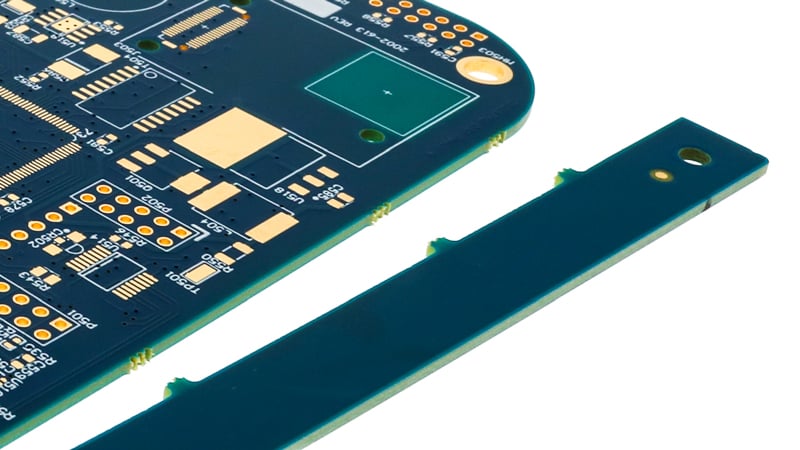As the printed circuit board’s physical size became smaller in one or both directions, it quickly became an issue for both the raw PCB supplier and the contract manufacturer to manage the parts on certain equipment. Processes like routing, electrical test, and packaging added cost to production for either time or scrap. Fallout was an issue that recovery was not possible.
Adding multiple parts to a frame or an array and using tabs to hold the single pieces in place have been used to process printed circuit boards (PCBs) for many years but not without issues.
In this blog post, we will discuss the types of tabs and how to minimize the issues left behind after breaking the individual parts out of the array.
When to Palletize Circuit Board and Why?
Palletization was introduced for manufacturing for a couple of reasons. First, the smaller printed circuit boards were more difficult to manage through the manufacturing and assembly processes. By smaller, I mean less than 2 inches in any one direction or both. The smaller the parts became the more challenges production had in some areas.
For the raw card, we manufacture in a master form, standard 18” x 24”. For a part that is singles (1 up) and is 2” x 2”, we can process 70 individual pieces on a master, cut the PCB in half to 1” X 1”, 280 parts per master, that’s a lot of parts.
“But why is this difficult,” you may be asking? Well, equipment for one, in our case, removal from the master panel. The routing process is time-consuming; when the router cuts the PCB shape there is also a vacuum removing the dust and debris from the surface. When the PCB is completely routed it is possible to vacuum up the smaller parts. Testing is more difficult for these tiny parts as well, leaving us to test them in the master. Never mind adding UL, date code, and serialization, there is just limited space for this type of add.
For these reasons, the pallet or arrays were introduced by manufacturers of PCBs or contract manufacturers. Smaller parts held by tabs were more manageable for production and assembly houses. There certainly are more wasted materials but less handling, less scrap, and easier to process made it a win.
Tabs
The tab portion of the array is typically 0.100” to 0.150” wide and has non-plated holes or more commonly known as mouse bites, which are drilled through the tab for ease of breaking and removal from the array. Depending on the design of the tab the holes may be different sizes. There are several types of breakaway holes used for different reasons. For example, off-board edge, on-board edge, and a staggered combined. Let’s go through each type for a better understanding.

When breakaway holes are added appropriately to a PCB edge and waste rail, the rail will be supporting processes and will break away from the part, leaving behind little evidence of the tab.
Off-board edge means the tab has breakaway holes that are totally off the board edge with just the radius near the PCB kissing the actual edge. This type of breakaway design tends to leave behind more debris that needs to be manually removed. In some cases, the part has copper too close to the edges to allow for the hole to be on the PCB at all. It is also possible that the parameter of the part is not a critical dimension for fit, so the removal of debris is not an issue.
On-board edge allows for more of the perforation holes to be on the board’s edge. The location of the holes will depend on where any copper features, lands, or holes are located on the board. When placing the tab, the engineer will consider all features to prevent damaging the integrity of the PCB. Typically, the copper is recommended to be 0.015” from the actual board edge. Holes drilled on the board edge require a greater distance from radius to copper to prevent fracturing in the copper area.
Combination breakaway or mouse bites are used to minimize waste material left behind. Using the same 0.100” tab and adding five holes to the tab aids in breaking. The two outer holes will be larger and sit off the board edge while the three smaller holes will sit on the board edge. The larger holes will aid in breaking where the rout path meets the tab while the three smaller holes secure the tab and the PCB.
Breakaways
One item often forgotten is the waste rails or frame around the array, the panel or array. The rails are designed to withstand handling in final manufacturing processes and during assembly. A sturdy array is crucial to limiting fall out due to breaking or bending. Securing the parts with solid rails for support is advantageous but can also make it tough to remove the pieces when the part is completely assembled.

Break away holes on the actual PCB edge attach necessary waste rails to the PCB to aid in processing manufacturing and assembly.
An array too sturdy may cause costly fallout from fracturing due to excessive force when trying to remove the boards from the frame. Adding break holes to the rails will aid in disassembly without interrupting the integrity of the part. When done correctly the parts will withstand assembly and be easily removed after.
Summary
When thinking about your PCB design and layout, consult your circuit board supplier. Discuss the options for array setup. Make sure to keep the copper 0.010” - 0.015” from the edge when possible to allow for proper array setup. When this isn’t possible, discuss the breakaway tab option for your best results for boards less than 2 inches in either axis. Consult your contract manufacturer about what works best for them. Consider component overhang on larger printed circuit boards to use a rail to support the part when being applied.
Key Takeaways
- Breakaway Tabs Improve Handling of Small PCBs: For PCBs smaller than 2 inches, palletizing them in arrays using breakaway tabs helps improve handling, reduces scrap, and increases manufacturing efficiency across routing, testing, and assembly processes.
- Different Breakaway Tab Designs Serve Different Purposes: Off-board, on-board, and combination (staggered) mouse bite designs offer varying trade-offs between ease of removal and residue left behind. The right design depends on PCB edge constraints, copper placement, and dimensional tolerance requirements.
- Sturdy Rails Support Manufacturing but Need Smart Breakaway Features: Waste rails surrounding the PCB array offer essential structural integrity during assembly but can cause cracking or board damage if not designed with appropriate break holes to aid in smooth separation.
- Copper Clearance from Edges is Crucial for Clean Breaks: Maintaining a recommended copper clearance of 0.010” to 0.015” from the PCB edge allows safe placement of breakaway holes, minimizing the risk of damaging copper traces during separation.
- Early Collaboration Prevents Post-Assembly Issues: Collaborating with your PCB supplier and contract manufacturer early in the design process ensures optimal array layout, minimizes production challenges, and prevents costly fallout or damage during board separation.
















